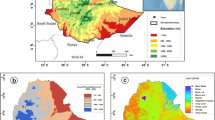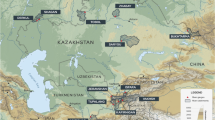Abstract
To identify the changing characteristics of runoff and climate change trends and their relationship in the Three-River Headwaters Region (TRHR), this study uses the runoff and meteorological data of three hydrological gauging stations and 12 meteorological stations across the TRHR for the period from January 1960 to December 2009 as the research subjects. The runoff coefficient (RC), ratio of monthly maximum/minimum runoff, and flow duration curves (FDCs) were calculated to identify spatio-temporal variations in runoff and reflect the change in hydrological regime. Results showed an insignificant decrease in annual runoff both in the Yellow River Headwater Region (YERHR) and the Lantsang River Headwater Region (LARHR), whereas it increased in the Yangtze River Headwater Region (YARHR). The RC of the three sub-regions showed a decreasing trend, the LARHR maintained a high mean value of 0.55, followed by a lower value in the YERHR (0.32), and that in the YARHR was the lowest at only 0.23. The variations in monthly maximum/minimum runoff were synchronized; their ratios were relatively steady in the study period. The flow duration analysis showed a remarkable decline in high runoff (at a frequency of 5–15%) in the three sub-regions after 1990. The runoff characteristics showed an overall decrease in the YERHR, the moderate runoff (at the frequency of 15–30% and 40–70%) of the YARHR showed an obviously increase, and the runoff of the LARHR was relatively steady. The relationship between precipitation, temperature and runoff illustrated that precipitation was the dominant factor in runoff generation, whereas the impacts of temperature on regional hydrological regime should not be neglected. Results of this study are of practical significance for water resources management and evaluation of the impacts of climatic change on the hydrological regime in a long-term consideration.








Similar content being viewed by others
References
Abdul Aziz OI, Burn DH (2006) Trends and variability in the hydrological regime of the Mackenzie River Basin. J Hydrol 319:282–294
Cao L, Pan S (2014) Changes in precipitation extremes over the “Three-River Headwaters” region, hinterland of the Tibetan Plateau, during 1960–2012. Quat Int 321:105–115
Castellarin A, Galeati G, Brandimarte L, Montanari A, Brath A (2004) Regional flow-duration curves: reliability for ungauged basins. Adv Water Resour 27:953–965
Castellarin A, Camorani G, Brath A (2007) Predicting annual and long-term flow-duration curves in ungauged basins. Adv Water Resour 30:937–953
Cheng G, Wu T (2007) Responses of permafrost to climate change and their environmental significance, Qinghai‐Tibet Plateau. J Geophys Res-Earth (2003–2012) 112
Déry SJ, Wood E (2005) Decreasing river discharge in northern Canada. Geophys Res Lett 32
Ganora D, Claps P, Laio F, Viglione A (2009) An approach to estimate nonparametric flow duration curves in ungauged basins. Water Resour Res 45
Hamed KH (2008) Trend detection in hydrologic data: the Mann–Kendall trend test under the scaling hypothesis. J Hydrol 349:350–363
IPCC (2013) Climate cahange 2013: the physical science basis. contribution of working group I to the fifth assessment report of the intergovernmental panel on climate change. Cambridge University Press, Cambridge, United Kingdom and New York
Kendall M (1975) Rank correlation methods. Charles Griffin, London
Lan Y, Zhao G, Zhang Y, Wen J, Liu J, Hu X (2010) Response of runoff in the source region of the Yellow River to climate warming. Quat Int 226:60–65
Li M, Shao Q, Zhang L, Chiew FH (2010) A new regionalization approach and its application to predict flow duration curve in ungauged basins. J Hydrol 389:137–145
Li B, Chen Y, Chen Z, Li W (2012) Trends in runoff versus climate change in typical rivers in the arid region of northwest China. Quat Int 282:87–95
Li L, Shen H, Dai S, Li H, Xiao J (2013) Response of water resources to climate change and its future trend in the source region of the Yangtze River. J Geogr Sci 23:208–218
Liang L, Li L, Liu C, Cuo L (2013) Climate change in the Tibetan Plateau Three Rivers Source Region: 1960–2009. Int J Climatol 33:2900–2916
Liu X, Zhang J, Zhu X, Pan Y, Liu Y, Zhang D, Lin Z (2014) Spatiotemporal changes in vegetation coverage and its driving factors in the Three-River Headwaters Region during 2000–2011. J Geogr Sci 24:288–302
Liucci L, Valigi D, Casadei S (2014) A new application of Flow Duration Curve (FDC) in designing run-of-river power plants. Water Resour Manag 28:881–895
Ma X, Yasunari T, Ohata T, Natsagdorj L, Davaa G, Oyunbaatar D (2003) Hydrological regime analysis of the Selenge River basin, Mongolia. Hydrol Process 17:2929–2945
Mann HB (1945) Nonparametric tests against trend. Econometrica: J Econometric Soc 245–259
Middelkoop H et al (2001) Impact of climate change on hydrological regimes and water resources management in the Rhine basin. Clim Chang 49:105–128
Mimikou M, Kanellopoulou S, Baltas E (1999) Human implication of changes in the hydrological regime due to climate change in Northern Greece. Global Environ Chang 9:139–156
Mohamoud YM (2008) Prediction of daily flow duration curves and streamflow for ungauged catchments using regional flow duration curves. Hydrol Sci J 53:706–724
Nijssen B, O’Donnell GM, Hamlet AF, Lettenmaier DP (2001) Hydrologic sensitivity of global rivers to climate change. Clim Chang 50:143–175
Niu L, Ye B, Li J, Sheng Y (2011) Effect of permafrost degradation on hydrological processes in typical basins with various permafrost coverage in Western China. Sci China Ser D 54:615–624
Qian K, Wang XS, Lv J, Wan L (2014) The wavelet correlative analysis of climatic impacts on runoff in the source region of Yangtze River, in China. Int J Climatol 34:2019–2032
Sen PK (1968) Estimates of the regression coefficient based on Kendall’s tau. J Am Stat Assoc 63:1379–1389
Shiklomanov A, Lammers R, Rawlins M, Smith L, Pavelsky T (2007) Temporal and spatial variations in maximum river discharge from a new Russian data set. J Geophys Res-Biogeo 2005–2012:112
Smith LC, Pavelsky TM, MacDonald GM, Shiklomanov AI, Lammers RB (2007) Rising minimum daily flows in northern Eurasian rivers: A growing influence of groundwater in the high‐latitude hydrologic cycle. J Geophys Res-Biogeo (2005–2012) 112
Theil H (1950) A rank invariant method of linear and polynomial regression analysis, part 3. Neth Akad Wet Proc 53:1397–1412
Viglione A, Merz R, Blöschl G (2009) On the role of the runoff coefficient in the mapping of rainfall to flood return periods. Hydrol Earth Syst Sci 13:577–593
Viola F, Noto L, Cannarozzo M, Loggia GL (2011) Regional flow duration curves for ungauged sites in Sicily. Hydrol Earth Syst Sci 15:323–331
Wainwright J, Parsons AJ (2002) The effect of temporal variations in rainfall on scale dependency in runoff coefficients. Water Resour Res 38:7-1–7-10
Wang G, Hu H, Li T (2009) The influence of freeze–thaw cycles of active soil layer on surface runoff in a permafrost watershed. J Hydrol 375:438–449
Wang G, Liu G, La L (2012) Spatial scale effect on seasonal streamflows in permafrost catchments on the Qinghai–Tibet Plateau. Hydrol Process 26:973–984
Wang Y, Ding Y, Ye B, Liu F, Wang J (2013) Contributions of climate and human activities to changes in runoff of the Yellow and Yangtze rivers from 1950 to 2008. Sci China Ser D 56:1398–1412
Waseem M, J-y S, Kim T-W (2015) Comparing spatial interpolation schemes for constructing a flow duration curve in an ungauged basin. Water Resour Manag 29:2249–2265
Woo MK, Kane DL, Carey SK, Yang D (2008) Progress in permafrost hydrology in the new millennium. Permafrost Periglac 19:237–254
Wu Q, Zhang T (2008) Recent permafrost warming on the Qinghai‐Tibetan Plateau. J Geophys Res-Atmos 1984–2012:113
Xiong L, Yu K, Zhang H, Zhang L (2013) Annual runoff change in the headstream of Yangtze River and its relation to precipitation and air temperature. Hydrol Res 44:850–874
Xu J (2011) Variation in annual runoff of the Wudinghe River as influenced by climate change and human activity. Quat Int 244:230–237
Xu B et al (2009a) Black soot and the survival of Tibetan glaciers. Proc Natl Acad Sci U S A 106:22114–22118
Xu Z, Zhao F, Li J (2009b) Response of streamflow to climate change in the headwater catchment of the Yellow River basin. Quat Int 208:62–75
Xue B-L, Wang L, Li X, Yang K, Chen D, Sun L (2013) Evaluation of evapotranspiration estimates for two river basins on the Tibetan Plateau by a water balance method. J Hydrol 492:290–297
Yang D, Kane DL, Hinzman LD, Zhang X, Zhang T, Ye H (2002) Siberian Lena River hydrologic regime and recent change. J Geophys Res-Atmos (1984–2012) 107:ACL 14-11-ACL 14-10
Yang D, Ye B, Shiklomanov A (2004) Discharge characteristics and changes over the Ob River watershed in Siberia. J Hydrometeorol 5:595–610
Yang M, Nelson FE, Shiklomanov NI, Guo D, Wan G (2010) Permafrost degradation and its environmental effects on the Tibetan Plateau: a review of recent research. Earth-Sci Rev 103:31–44
Yao Z, Liu Z, Huang H, Liu G, Wu S (2013) Statistical estimation of the impacts of glaciers and climate change on river runoff in the headwaters of the Yangtze River. Quat Int 336:89–97
Ye B, Yang D, Zhang Z, Kane DL (2009) Variation of hydrological regime with permafrost coverage over Lena Basin in Siberia. J Geophys Res-Atmos (1984–2012) 114
Yi X, Li G, Yin Y (2012) Temperature variation and abrupt change analysis in the Three-River Headwaters Region during 1961–2010. J Geogr Sci 22:451–469
Yi X, Li G, Yin Y (2013) Spatio-temporal variation of precipitation in the Three-River Headwater Region from 1961 to 2010. J Geogr Sci 23:447–464
Yue S, Wang C (2004) The Mann-Kendall test modified by effective sample size to detect trend in serially correlated hydrological series. Water Resour Manag 18:201–218
Yue S, Pilon P, Cavadias G (2002) Power of the Mann–Kendall and Spearman’s rho tests for detecting monotonic trends in hydrological series. J Hydrol 259:254–271
Zhang S, Hua D, Meng X, Zhang Y (2011) Climate change and its driving effect on the runoff in the “Three-River Headwaters” region. J Geogr Sci 21:963–978
Acknowledgments
We would like to thank the China Meteorological Administration for providing the meteorological data. This study was funded by the National Basic Research Program of China (973 Program) (Grant No.2013CBA01807). The authors are grateful to the anonymous reviewers and the editors for their constructive comments and suggestions which have substantially improved the presentation.
Author information
Authors and Affiliations
Corresponding author
Rights and permissions
About this article
Cite this article
Mao, T., Wang, G. & Zhang, T. Impacts of Climatic Change on Hydrological Regime in the Three-River Headwaters Region, China, 1960-2009. Water Resour Manage 30, 115–131 (2016). https://doi.org/10.1007/s11269-015-1149-x
Received:
Accepted:
Published:
Issue Date:
DOI: https://doi.org/10.1007/s11269-015-1149-x




